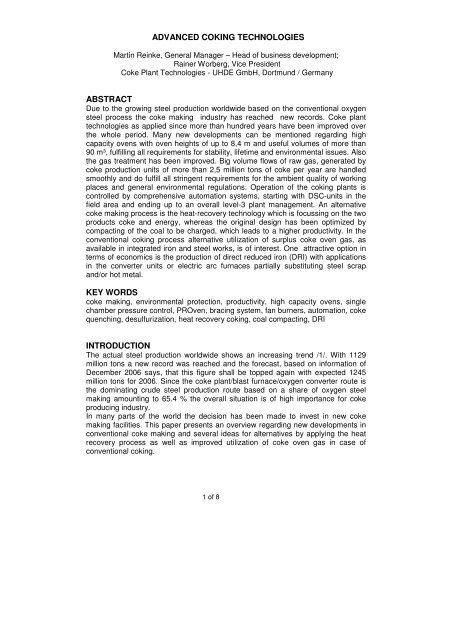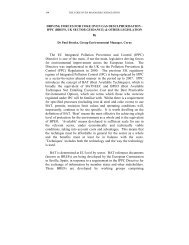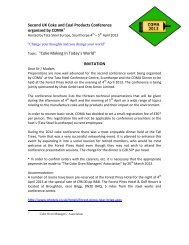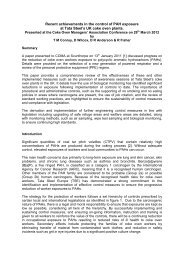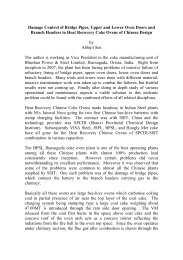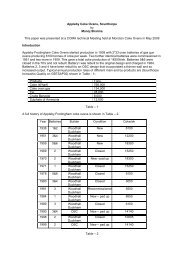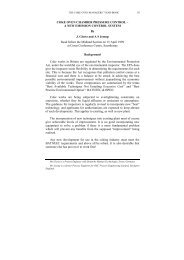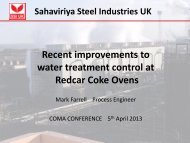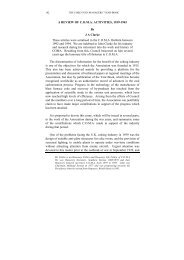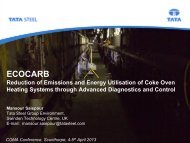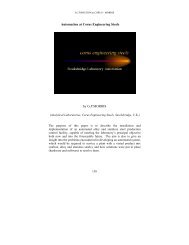advanced coking technologies abstract key words introduction
advanced coking technologies abstract key words introduction
advanced coking technologies abstract key words introduction
- No tags were found...
You also want an ePaper? Increase the reach of your titles
YUMPU automatically turns print PDFs into web optimized ePapers that Google loves.
ADVANCED COKING TECHNOLOGIESMartin Reinke, General Manager – Head of business development;Rainer Worberg, Vice PresidentCoke Plant Technologies - UHDE GmbH, Dortmund / GermanyABSTRACTDue to the growing steel production worldwide based on the conventional oxygensteel process the coke making industry has reached new records. Coke plant<strong>technologies</strong> as applied since more than hundred years have been improved overthe whole period. Many new developments can be mentioned regarding highcapacity ovens with oven heights of up to 8,4 m and useful volumes of more than90 m³, fulfilling all requirements for stability, lifetime and environmental issues. Alsothe gas treatment has been improved. Big volume flows of raw gas, generated bycoke production units of more than 2,5 million tons of coke per year are handledsmoothly and do fulfill all stringent requirements for the ambient quality of workingplaces and general environmental regulations. Operation of the <strong>coking</strong> plants iscontrolled by comprehensive automation systems, starting with DSC-units in thefield area and ending up to an overall level-3 plant management. An alternativecoke making process is the heat-recovery technology which is focussing on the twoproducts coke and energy, whereas the original design has been optimized bycompacting of the coal to be charged, which leads to a higher productivity. In theconventional <strong>coking</strong> process alternative utilization of surplus coke oven gas, asavailable in integrated iron and steel works, is of interest. One attractive option interms of economics is the production of direct reduced iron (DRI) with applicationsin the converter units or electric arc furnaces partially substituting steel scrapand/or hot metal.KEY WORDScoke making, environmental protection, productivity, high capacity ovens, singlechamber pressure control, PROven, bracing system, fan burners, automation, cokequenching, desulfurization, heat recovery <strong>coking</strong>, coal compacting, DRIINTRODUCTIONThe actual steel production worldwide shows an increasing trend /1/. With 1129million tons a new record was reached and the forecast, based on information ofDecember 2006 says, that this figure shall be topped again with expected 1245million tons for 2006. Since the coke plant/blast furnace/oxygen converter route isthe dominating crude steel production route based on a share of oxygen steelmaking amounting to 65.4 % the overall situation is of high importance for cokeproducing industry.In many parts of the world the decision has been made to invest in new cokemaking facilities. This paper presents an overview regarding new developments inconventional coke making and several ideas for alternatives by applying the heatrecovery process as well as improved utilization of coke oven gas in case ofconventional <strong>coking</strong>.1 of 8
IMPROVEMENTSIncreasing economic and environmental requirements led to various developments.For the conventional <strong>coking</strong> process this is valid for the battery part as well as forthe gas treatment. Alternatives refer to the heat-recovery process as well as toother utilization of the coke oven gas produced in the conventional process.Conventional CokingHigh Capacity Production Units - Chamber volumes of coke ovens started inearlier times with some 20 m³ in connection with oven heights of 4m, reachedapproximately 50 m³ for 7m – batteries leading to 76 m³ for the former Kaiserstuhl<strong>coking</strong> plant with an oven height of 7.6 m. In addition to the increased oven heightsalso the chamber width has been changed from former 400 to 450 mm toapproximately 600 mm. The table in Fig. 1 summarizes the main technical featuresof different units for an annual coke production of 2 million tons of coke.Oven heightNumber of batteriesNumber of ovensUseful volume p. ovenNumber ofpushes/charges p. dayTotal length of sealings(doors, standpipes,charging holes)Required space for thebatteriesSets of oven machinesOperation teams7.6 m 6.0 m 4.3 m2 4 5140 220 32576 m³ 34 m³ 20 m³135 300 5204.8 km 6.0 km 6.5 km40,000 m 2 50,000 m 2213255,000 m 253Fig. 1 Comparison of ovens with different heights and useful volumesFurther improvements have been reached at least with the <strong>coking</strong> plantSchwelgern in Germany with an oven height of 8.4 m and a chamber volume of 93m³, producing 2.6 million tons of coke per year /2/.In case of high capacity ovens the advantages are obvious regarding the requiredspace and environmental impacts. Of high importance is the saving of operationcost due to the fact that only one operation team is needed instead of 2respectively 3 teams for the common ovens. Also the number of sets of ovenmachines comprises potentials for saving of investment and operation cost for thehigh capacity ovens.In case of the installation of high capacity ovens also the related gas treatmentplants have been designed accordingly for coke oven gas flows of 120,000respectively 155,000 m³ / h as single line units, providing comparable advantages.Battery partFor ensuring certain stability properties and homogeneous temperaturedistributions during heating up and normal operation both of influence for asatisfactory longevity and operation performance of batteries, the design conceptshave been improved and adapted accordingly. In parallel many environmentalissues have been developed respectively optimized.2 of 8
Chamber width – Apart from an influence on useful chamber volume a wider ovenchamber leads to higher absolute shrinkage of coal at the end of carbonization,followed by wider gaps between oven walls and outer surface of the coke cake.This results in less pushing forces required due to reduced frictions between thecoke and the oven walls. Consequently blocked ovens to be pushed have not beenobserved at such batteries. Last mentioned advantage additionally provides lessrisks for damage of the refractory material and increases the lifetime. A furtherpositive impact on the lifetime is caused by the following effect. Since typical<strong>coking</strong> times for ovens with wider average width are in the range of 25 h lesspushes per oven and day are the result in comparison to ovens with narrower ovenwidths and <strong>coking</strong> times of typical 18 h <strong>coking</strong> times.Another advantage caused by the wider is an increased coke quality, which meansa particle size distribution with an increase of greater coke particles can beobserved.In some cases the aforementioned higher absolute shrinkage values of the coalare used for an increase of the coke yield by applying coal blends with a loweramount of volatiles.Bracing system - Proper working bracing systems have been developed based onresults from research programs and practical experiences. In connection withstrong heating wall bonds the system CONTROLPRESS ® from Uhde providessufficient prestressing to the refractory material which can safely withstand the<strong>coking</strong> pressure and all other forces from the operation. A schematic arrangementof this bracing system is shown in Fig. 2.F oF 1F 2F 3F 4F 5F 6F 710 20 30 40 50 60Load on heating wall in kN per mRequired load distributionsfor different oven heightsF 8F uFig. 2 CONTROLPRESS ®bracing systemHeating-up procedure - Homogeneous temperature distributions during theheating up period of a battery are also important for a long life. For this reasonUhde has developed a new procedure by applying external fan burners /3/. Byproducing an overall high volume flow of flue gas they generate a positive pressurein the entire oven bloc right from the beginning and this is accompanied byoptimum heat transfers inside the whole system. An arrangement of burners showsin Fig. 3. Local overheating in the area behind the coke oven door is ruled out.Fig. 3 Arrangement ofheating up burners3 of 8
Dutch ovens for protecting the brickwork and man power for safeguarding of theflames, as necessary in the past, are no longer required.Heating systems - One important environmental aspect is the formation of NO xduring the combustion of underfiring gas for the battery. Staged air heating incombination with internal waste gas recirculation are generating a long and “cool”flame and are minimising NO x concentrations in the waste gas. Along with thereduction of NO x -forming an improvement of the vertical heat distribution will beobtained. The COMBIFLAME ® heating system providing above mentionedcharacteristics is schematically demonstrated in Fig. 4.Fig. 4 COMBIFLAME ® - heating systemwith internal recirculation of wastegas with and 2-respectively3-staged - air heatingIndividual pressure control with PROven ® - Fugitive emissions from ovenclosures during carbonization can be reduced by proper sealing systems.A totally new aspect in this connection comes up with the installation of thePROVen ® System. It works with a suction in a range of 2.5 to 3.5 mbar in thecollecting main and a controlled low positive pressure in the oven chamberaccording to the carbonization status of the individual oven. This leads at least toan almost emission-free battery also during charging. This system has beeninstalled and successfully commissioned at the two new coke oven batteries of the<strong>coking</strong> plant Schwelgern in Germany /4/. Further installations / commissioning shallbe carried out at new batteries in China and Korea as well as at existing batteriesin Brazil. Fig. 5 shows a schematic arrangement of the PROven ® system. It mainlyconsists of the:- crown tube, being a pipe with calibrated slots cut into its end- FixCup which is a conical shaped vessel with a drain hole at its bottom.- overflow regulation device, comprising of the regulation part for the water leveland the plug for the drain hole in the FixCup.- pressure controller, taking a pressure measurement in the standpipe elbow- fast flooding pipe which supplies ammonia liquor to quickly fill the FixCupFig. 5 PROven ® -system– general arrangement4 of 8
During charging of an oven, the overflow regulation device including the plug islifted to its uppermost position. The FixCup is drained completely and the raw gascan flow undisturbed into the gas collecting main. In this position the full suction ofthe gas collecting main is available in the standpipe elbow, providing for a perfectdischarge of the large initial gas amounts during charging. After charging theoverflow regulation device is lowered, closing the drain hole of the FixCup by theplug. The ammonia liquor sprayed into the standpipe elbow is collected in theFixCup and the water level slowly rises up to the overflow level adjusted by theoverflow regulation device. In this control position, the slots of the crown tube arepartly immersed into the water, reducing the free space through which the raw gascan be drawn into the gas collecting main. With rising water level the free space isreduced, while by lowering the water level the free space is increased. Thepressure controller constantly compares the actual pressure in the standpipe elbowwith the desired set point, regulating the water level in the FixCup via the controlvalve, pneumatic cylinder and overflow regulation device accordingly.When the coal in an oven chamber is fully carbonized and there is no further rawgas produced, the slots in the overflow regulation device are completely closed. Bythe rising water level, the slots in the crown tube are flooded completely,disconnecting the oven from the gas collecting main.Due to the high performance of this system in terms of environmentalimprovements Uhde was successful in receiving an acknowledgement by an EPAof the USA for a pad up rebuild of an existing conventional battery in connectionwith the installation of PROven ® . This means with regard to environmentalperformance PROven ® is a real alternative to the heat-recovery <strong>coking</strong> process.Coke Quenching - CSQ stands for Coke Stabilisation Quenching and is an<strong>advanced</strong> wet quenching system with low environmental impact /5/. It wasdeveloped as an environmental friendly alternative to Coke Dry Quenching. Theemissions of dust are as low as for a CDQ, the gaseous emissions are even less.Investment, operation and maintenance cost are substantially lower. The processitself is a combination of bottom- and top quenching providing extreme shortcooling time ( see Fig. 6 ).baffle system 2(plastic)scrubber 2baffle system 1(stainless)scrubber 190°top quenchMmake up waterbaffle cleaningMMbottom quenchFig. 6 CSQ – Quench systemThe coke is popped up approximately 30m during quenching. An additional hoodinside the quench tower prevents the down falling coke from being deposedoutside the quench car. The coke is fairly stabilized by the described handling andneeds no further treatment except screening as usual.With 70m the CSQ-quench tower at Schwelgern is almost double in height than thenormal case. A second unit of baffles for the removal of particles is arranged in the5 of 8
tower leading to specific emissions comparable to the CDQ-performance.Emissions of less than 10g of particles per ton of coke have been reached.Gas treatmentReduction of investment and operation cost as well as improvements of processefficiencies are the requirements to be fulfilled for modern gas treatment units.As an example the well known Claus Plant for the treatment of sour gas has beensimplified and developed /6/. This MONOCLAUS ® -process is shown in Fig. 7.LP-SteamClaus ReactorH 2 S - and NH 3 -vapoursClaus KilnProcessgasCoolerSulfurCondenserTail GasSulfurAirFig. 7 MONOCLAUS ® -processBy using a horizontal type Claus-furnace with a catalytic cracking stage forammonia and HCN and by choosing only one Claus-reactor for the conversion ofH 2 S to pure sulfur, the scope of equipment, steel structure and piping work can bereduced significantly. Although the yield of H 2 S conversion is smaller comparedwith two Claus-reactors, it is of no importance because the tail gas will be recycledto the coke oven gas. However, a minor extension of the upstream process unitsdue to the additional amount of tail gas and H 2 S has to be considered pure liquidsulfur, which can be sold in liquid form or solidified in a following flaker unit.AutomationThe COKEMASTER ® - a system for coke plant automation enables to operate acoke-oven plant at optimum efficiency and is equipped with the latest state-of-theartautomation technology. Because of it’s modular design it allows for tailor-madesolutions according to the customer's specific requirements /7/. The modules are:The AutoTherm TM measuring system uses its six infrared sensor heads to measurethe surface temperatures of the two heating walls at three different levels duringeach coke-pushing operation.The ManuTherm TM system is an infrared pyrometer with integral data memory fortaking manual measurements at the heating flues. These temperaturemeasurements are fed into the computer system and can be used for furthercalculations and evaluations.The BatControl TM system calculates and controls the amount of heat required forthe battery, taking into account all relevant operating parameters such as coalquality, coal moisture, coke-pushing schedule, etc.The PushSched TM system is an automatic pushing and charging schedulecalculation program. The production plan is re-calculated continuously after everycoke-pushing operation considering special operational situations such as "ovenwith extended <strong>coking</strong> time" or "oven shut down". The resulting production scheduleis transmitted to the machines.6 of 8
The GasControl TM system is a process model for gas treatment plants. It useschemical and thermodynamic mass equilibrium and streams to rate each individualgas treatment unit. The model is supplied with the necessary on-line processvariables of the plant instrumentation in real time mode and the process iscalculated dynamically. The control parameters that deliver the best operatingresults are re-transmitted to the plant instrumentation in order to set the localcontrollers in the "real" plant.Maintenance and Training - To reduce the need for on-site manpower formaintenance and service, UHDE provides a direct link between its higher levelautomation systems and the development center in Germany. A router at UHDE’shead office can be connected via digital telephone line or via VPN - technologythrough the Internet with a network server on site. With the proper authorization, aservice technician can log into the automation system on site for trouble shooting.ALTERNATIVESHeat Recovery CokingA system, which has already been applied in a real production processes withpredominant demand for coke is the non- respectively heat-recovery <strong>coking</strong> /8/.A new generation of heat recovery ovens is be operated by applying compacting ofcoal before charging /9/. A cohesive block of charge coal that has approximatelythe same length and width dimensions as the oven chamber is produced, see Fig.8. The increase in the bulk density of the coal improves the coal throughput of theoven.Fig. 8 Charging of a compacted coalinto a heat recovery ovenAlternative Utilization of Coke Oven GasSurplus coke oven gas available as a result of measures aimed at optimizing theenergy consumption of integrated iron and steel works, including the tar producedin the conventional <strong>coking</strong> plant can be utilized for the production of DRI /10/.TheDRI can be used as shown in Fig. 9. The mentioned cost figures are representingthe sum of capital and operating expenses per t of slabs in all options for a totalproduction of 4 million tons of slab per year. Good results are reached by theutilization in the BOF and EAF. Based on European figures a return on investmentwithin 4 years for the installation of a DR-plant was calculated with savings ofapproximately 16 US$ per ton of produced slabs for option 5. Additionally it shouldbe mentioned that the quality of the produced steel is expected to be better, sinceDRI does not contain any unwanted non ferrous metallic elements like importedscrap. Also less specific CO 2 – emissions per ton of steel can be expected, as lesscarbon as reducing agent is necessary.7 of 8
Base Case : without DRI Option 1387 US$ / tDRI- ProductionMarketOption 2371 US$ / tBFnotconsiderednotconsideredhotDRIEAFOption 3380 US$ / tcoldDRIBOFOption 4373 US$ / thotDRIBOFOption 5371 US$ / tFig. 9 Different utilisation for DRISUMMARYA variety of improvements have been applied to the conventional coke making.The new <strong>coking</strong> plant Schwelgern is a milestone with regard to the battery part,gas treatment and overall automation. In all cases environmental as well aseconomic issues have been considered and optimized.An interesting enhancement is the alternative utilization of coke oven gas e.g. forthe production of DRI with high potentials for minimizing of investment andproduction costs.In cases, where the demand is predominantly for coke and energy the heatrecovery <strong>coking</strong> is a reasonable option, especially in connection with compactedcoal charges.REFERENCES/1/ H.B. Lüngen: Actual status and future aspects of ironmaking in Europe, presented atEuro Coke Summit 2006, Düsseldorf, Germany, 10-12 April 2006/2/ R. Neuwirth, D. Schuster; State-of-the-art plant technology for cokemaking; MPT-International (2003) Vol. 26; p. 38-48/3/ M. Reinke, U. Kochanski, R. Schumacher, M. Heyer; Praxis der Inbetriebnahme vonKoksöfen mit Standard-Industriebrennern, presented at Fachtagung Kokereitechnik, Essen,Germany 10-11- May 2001/4/ J. Spitz,, U. Kochanski, K.-P. Leuchtmann, F. Krebber, Operation experiences gainedwith PROven, Proceedings on the 5 th European Coke and Ironmaking Congress, Stockholm,Sweden 12-15 june 2005, p.Tu2:1-1 to 15/5/ A. Hannewald, New wet quenching process combines economy and environmentalcompatibility in cokemaking; MPT International 28 (2005) No.2(April), p.38-40/6/ D. Schuster, Desulfurisation of coke oven gas by <strong>advanced</strong> <strong>technologies</strong>, Proceedingson 3 rd China International Coking Technology and Coke Market Congress 2005, p. 308-318/7/ M. Reinke; K.P. Leuchtmannn, Coke Plant Automation, Proceedings on 4th ChinaInternational Coking Technology and Coke Market Congress 2006, p. 213-223/8/ P. Arendt; H.B. Lüngen; M. Reinke; Coventional slot oven or “heat recovery” oven ? ;Stahl und Eisen 126 (2006) No.1, p. 17-26/9/ R. Wright, R. Kim, F.-J. Schücker, Compacting of coal for heat recovery ovens,Proceedings on the 5 th European Coke and Ironmaking Congress, Stockholm,Sweden 12-15June 2005, p.Tu2:2-1 to 13/10/ P. Diemer, K. Knop, H.B. Lüngen, M. Reinke, C.-D. Wuppermann; Utilization of cokeoven gas for the production of DRI, Stahl und Eisen 127 (2007) No.1 (under preparation)8 of 8


